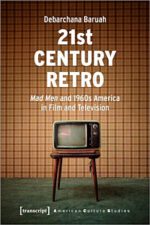Revivals of cultural and retrospectively oriented tendencies in music, fashion and design have been around for a long time. Many contemporary American and European TV productions successfully revisit the 1940s, 1950s and very often the 1960s.
 The shows differ greatly in their amount of historical correctness and the many important events that influence the protagonists and their lives.
The shows differ greatly in their amount of historical correctness and the many important events that influence the protagonists and their lives.
Author Debarchana Baruah offers a vocabulary to discuss such tales and their settings and aims, using one show, in particular, as an example. In her opinion, 21st Century Retro “… expects its findings to be widely applicable, it confides itself to retro film and television and even more specifically, to one retro television series: Mad Men.” The show premiered in 2007 and centered around the advertising executive Don Draper and his ups ad downs in his job in an agency and his family life. After 92 episodes, Mad Men ended with season 7 in 2015, and by that time had earned an incredible number of awards for design, writing, acting and directing.
The three parts of the study essentially are devoted to the idea of “retro,” its relationship with nostalgia and history, and the differences or common places retro (and the show) shares with historical productions. The individual five chapters of the parts deal with the pleasures of watching retro, what it does to audiences, the fun of finding anachronisms and references to authentic facts, and the success of retro – as a style and organizing theme – that owes much of its credibility to a network of authors who “tirelessly give retro its form.”
She uses an interdisciplinary approach to reveal the dedication behind retro film and television productions, and the unique requirements arranged for an approach that must fulfill several additional tasks to be taken seriously by its audiences, who look for authenticity, besides entertainment and story arcs. Step by step she exposes the philosophical and almost obsessive pleasures behind some basic ideas: “How does retro express its ironic stance? How does it interact with nostalgia (a category it is regularly conflated with)? How does retro use and appropriate its intertextualities (the fragments of the past)? What are the pleasures of retro? What mechanisms support retro in its positioning? How do people (fans) participate in a retro production? How does retro speak for itself?”
As retro productions are also self-reflective, cynical of the past and tend to be brainchildren, mostly of the baby-boomer generation; who (probably more often than not) want to reinforce their own generational ideas. Furthermore, the effect of TV as a (sometimes reliable) database or memory preserver plays a role. As “… since the late ‘80s, there is a return to the Holocaust and the Second World War in historical television and cinema. These productions are driven by an anxiety to preserve memories and from an awareness that the survivors of the Holocaust and the Second World War generation were being lost to age.”
All in all, her title actually provides data and comments enough for two individual explorations. As Mad Men, set in the 1960s in the US, of course is not the only 21st century retro show, if one of the most refined one; earlier TV productions already left a sketchy cannon, and many movies that look back on either an especially important date in history or the coming of age of a person or lineage.
So defining retro and the many impressions that built up some sort of credibility and identification with a certain person in a particular historical setting (which includes links to history, art, and music, in particular, or just fashion or interior design) alone makes the title quite readable. For that reason, chapter 4 is probably the most conclusive section here, as “Mad Men and its Paratexts” is something link an eye-opener; it connects the power and basic strategies of the retro idea and in detail shows how that is put to work for the show. The fact that the 1960s in the USA still exist as a decade exceptionally romanticized, obviously helped a lot.
Mad Men then, here actually appears as basically a case study, i.e. this example stands to prove the countless ideas of nostalgia, retro and imagined, and often glorified (as for example already in the movie Forrest Gump, but in a very different manner) past. So knowing the show definitely is a plus, but then Baruah enlarges on retro film very elaborately so that the methods identified may be perceivable even without ever having watched it.
“Retro has a distinct place within the energized cultures of memoralization,” she argues. “They detract from the historicity of events, by widening its lens to include the days leading up to, and the days following the events. The changing of the frames changes the story. Retros dwell on the legacies and aftermaths of national tragedies, political movements, and national victories; and they wrestle with what settles behind.”
21st Century Retro is a lush and exhaustive inspection of the ideas and tools of retro in film and TV, that will appeal to more than just a few readers, as nostalgia and audiovisual pleasures of the past seemingly attract all audiences sooner or later.
Review by Dr. A. Ebert © 2022
Debarchana Baruah. 21st Century Retro: “Mad Men” and 1960s America in Film and Television. (#32, American Culture Studies Series). transcript, 2021, 246 p.
